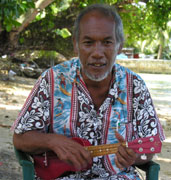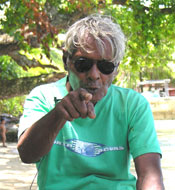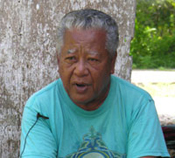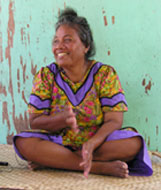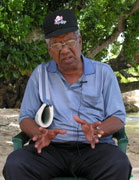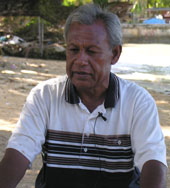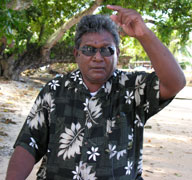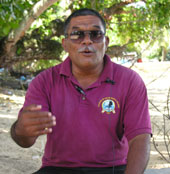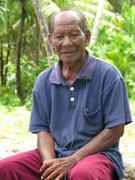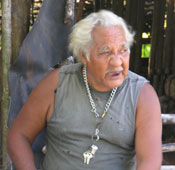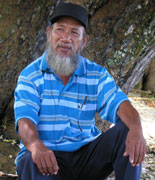



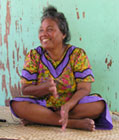
Traditional Marshallese tales range widely and serve many purposes. Foremost of their functions is education, whether to explain the origins of an unusual coral formation or to describe the best behavior when faced with a challenge. The same tale may take many forms, depending on who's telling it and where. Also, many tales come in parts, the totality of which only some story-tellers know. The story of Rilong, the giant irooj of Arno, for instance, was told to us in snippets by story-tellers on Arno. Only one story-teller (originally from Arno) knew the story in its entirety.
Traditional story-tellers were revered for their knowledge, which was a powerful legacy given to only a select few. There remain some stories -- or parts of stories -- that may never be captured for preservation because the knowledge they impart is too rich or too dangerous. It is clear that traditional stories are struggling for survival as new forms of entertainment and education prevail. Among the current generation of elders, the number of stories has diminished. Many story-tellers declined to share a number of stories with us because they did not feel well-versed in them. No doubt the versions of stories we have gathered, and will continue to gather, tell a story of its own: how traditional tales adapt to the changing times. The value in this collection of tales, therefore, lies not only in how it reveals the past but also how it illuminates the present.
To access the archive of each story teller, click on the story-teller's picture. The sub-headings indicate the topics discussed.
![]() Bwebwenato in Majel ko rekitbuuj elon men and im lon men ko rej jutak kaki. Jerbal eo aer imaantata ej nan katakin, emaron kin bwebwenato in jokjok in juon wod and jokjok eo ekkar nan kommane ilo ad jelmae juon aban. Juon bwebwenato emaron itok ilo elon nememe bedbed wot ion won eo ej bwebwenato kake ak ia eo bwebwenato ej komman ie. Ejjab men in wot ak elon bwebwenato ko walok ilo tibrikrik ko, im bwe jejjo wot remaronin jela dribieo in bwebwenato eo. Bwebwenato en ri-nakaio eo Rilong jen Arno kar bwebwenato kake non kim ilo mottan ko jen elon ri-bwebwenato. Ijoke, juon wot ri-bwebwenato (jen Mili) kar maron in bwebwenato kin Rilong jen jinoin non jemlokin.
Bwebwenato in Majel ko rekitbuuj elon men and im lon men ko rej jutak kaki. Jerbal eo aer imaantata ej nan katakin, emaron kin bwebwenato in jokjok in juon wod and jokjok eo ekkar nan kommane ilo ad jelmae juon aban. Juon bwebwenato emaron itok ilo elon nememe bedbed wot ion won eo ej bwebwenato kake ak ia eo bwebwenato ej komman ie. Ejjab men in wot ak elon bwebwenato ko walok ilo tibrikrik ko, im bwe jejjo wot remaronin jela dribieo in bwebwenato eo. Bwebwenato en ri-nakaio eo Rilong jen Arno kar bwebwenato kake non kim ilo mottan ko jen elon ri-bwebwenato. Ijoke, juon wot ri-bwebwenato (jen Mili) kar maron in bwebwenato kin Rilong jen jinoin non jemlokin.
Ri-bwebwenato ro etto kar lap aer kautej er kin jela ak kapeel ko ippaer. Kapeel kein raar jet ko im an jejjo wot. Ewor jet bwebwenato ro, ak mottan bwebwenato ko, im rejjamin pad im walok ilo jeje ak pija, kinke elap aer mwilal im aaeto. Ej alikkar bwe inon ak bwebwenato ko ad rej pukot aer jab mojno im jako ilo an lon lok kain men ko rej itok im bok jikier. Ilo ebeben in ritto ro kio, woran bwebwenato ko rejela emoj an ietlok. Elon ri-bwebwenato ro raar kwalok aer jab maron konono ippam itok wot jen aer enjake bwe ejabwe melele ippaer. Ejjelok am pere bwe bwebwenato ko kim ar rekooti rej kwalok juon aer make bwebwenato, eo im ej bwe inon im bwebwenato ko ad rej okoktak ippan an okoktak mour. Kin men in, aorok ko an bwebwenato kein ejjab wot kin ta ko rej kwalok kin ien ko etto, ak rej bareinwot kwalok kadkadin raan kein.
Nan tobar melele ko ikijjien kajojo ri-bwebwenato, jibed kajjien pija in ri-bwebwenato eo. Jeje ko dredrik rej kwalok ta ko konono kaki.
|
||
|
|
|
|
|
|
|
|
